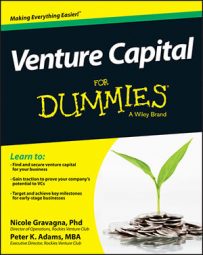Searching out a venture capital (VC) investor or company is the first part. After you feel comfortable that your company is ready and your deal is mature enough for investors, you will have to actually make contact. Doing this online at AngelList or Gust is one good way to approach investors.
Aside from the broad interest and inquiries that you might get from an AngelList profile, all other contact between you and investors will have to originate with you. Plan to do all of the reaching out and following up.
Although you may feel like investors are giving you the runaround and that you have to do all the legwork, it’s worth it. Be sure that you focus on time management while you are fundraising. Because closing this deal as soon as possible is in your best interest, it’s your responsibility to do all the reaching out.
Create a hit list of investors
When you plan your fundraising campaign, plan your investor hit list as well. Who would you most like to have on your board, in your deal, and on your side? Make a list of your most likely candidate investors with your team.
You and your team should be able to defend why you have added each person’s name to the list. This is really important because it enables you to target the right people without wasting a lot of time.
Your VC hit list will change in an iterative way. You may love the blog Redeye VC, written by Josh Koppelman at First Round Capital, and initially put that VC firm on your hit list.
Then after doing a little objective research, you discover that First Round Capital claims to be a seed stage-only firm. If your company is in B-round fundraising, you may not be a good fit. Back to the drawing board!
Throughout the process of fundraising, investors will become more or less attractive to work with. Change your hit list as you learn more. Eventually, your hit list will morph into an investor interest list. You will have dropped all the uninterested parties and kept all the interested parties. The investor contact list will be helpful later when you want to update potential investors on progress.
Research VC firms
VC websites have a lot of information. Generally, they offer an overview of the kinds of investments that the firm makes and include tombstones, thumbnail images of the companies in the VC portfolio. Research those portfolio companies to find out whether they’re anything like yours.
Pay particular attention to companies that are similar to yours but that would not be competitors. You can use this information to develop a story for the VC about how the decision-making process they used for similar companies would apply to yours. Be careful to make sure that those investments are going well for the VC, though; you don’t want to compare your company to a loser!
VCs must set up restrictions for the fund before they can do even a single investment. If your company falls outside those restrictions, the VC firm cannot work with you. Be sure you are contacting appropriate VC firms.
Getting to know you, VC-style
VCs are funny. If you were to ask VCs how easy it is to get in touch with them, almost inevitably, they’ll answer that it’s really easy. Ask any entrepreneur whether VCs are easy to get in touch with, and the most likely answer is a negative one. Why the discrepancy? There are probably a number of reasons, but we’re guessing it comes down to four basic things:
VCs know a bunch of VCs, so of course they can talk to VCs easily!
Entrepreneurs are intimidated by VCs and therefore don’t try as hard as they could to get attention.
Entrepreneurs spam every VC in the country with their pitch deck with a “to whom it may concern” cover letter without bothering to be selective in contacting the right companies.
Miscommunication occurs between VCs and entrepreneurs when the entrepreneur submits an application, the VC quietly rejects it, and the entrepreneur thinks his proposal hasn’t been seen.

